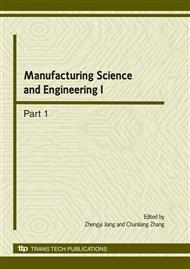p.1450
p.1454
p.1459
p.1463
p.1467
p.1471
p.1475
p.1479
p.1484
Brush Plated Multilayered Cu/Ni Coating from a Single Electrolyte and its Fretting Wear Behaviors
Abstract:
Brush plated of Cu/Ni multilayer coating from a single sulfate electrolyte was prepared. The influence of applied voltage on the composition of the deposit and deposition rate was investigated to optimize the plating parameters. Wear tests were carried out in ball-on-plate geometry unlubricated. Wear scar morphology was observed using scanning electron microscopy and optical microscopy. It was found that the brush plated multilayer coating was highly dense and free from porosity. The multilayer coating showed less wear than Ni coating brush plated from the same solution. The increase in the wear resistance of the multilayer coating was attributed to lubricating effect of the transform film formed by Cu wear particles.
Info:
Periodical:
Pages:
1467-1470
Citation:
Online since:
March 2010
Authors:
Keywords:
Price:
Сopyright:
© 2010 Trans Tech Publications Ltd. All Rights Reserved
Share:
Citation:


